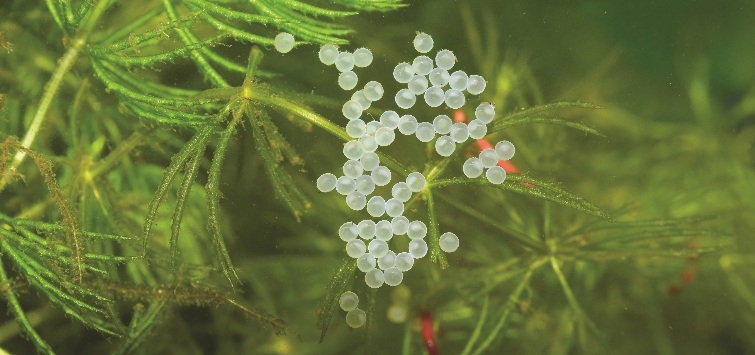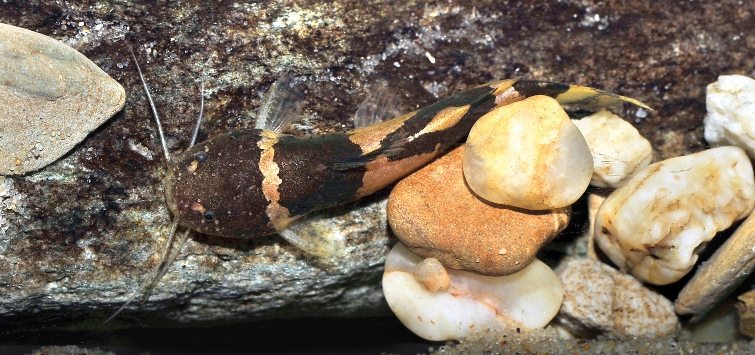A How-To Guide for Breeding Corydoras Catfish
Corydoras catfish, commonly known in the hobby as “cory cats” or “cories,” are probably the most popular of all catfish in the aquarium trade. They are small, attractive, social, undemanding, and harmless to the other residents of their tank. Some may even appear to wink at you as they rest on the bottom after grabbing a gulp of air from the surface—a sign of stress in some fish, but completely normal behavior for these interesting little cats. One of the fun things about keeping cories is that many species can be successfully bred and raised by the average hobbyist. You may even be surprised by the random appearance of tiny cory fry in well-planted community tanks, even without trying to breed them. Breeding Corydoras is generally easy, and most species tend to breed in the same manner. With close to 200 different species, there are some that are challenging and a few that use very different strategies, but most species can be bred using the same methods.
Tank Setup and Maintenance

A sandy bottom is best for a tank housing cories, as they will forage through the substrate face-first in search of food morsels.
Cories like to have room to roam and are bottom oriented, so long, low tanks are much better for them than taller tanks with less room on the bottom. These fish do well in planted tanks, and décor like driftwood and rocks that won’t affect water chemistry are fine, too.
In the South American wild, cories are usually found in creeks and small rivers off the main channels. The water tends to be clear and shallow, and the bottom, sandy or rocky, though sometimes they are found in mud-bottom streams as well. Leaf litter, branches, and small trees are usually present in the water.
In their aquarium, a sandy bottom is preferred, though fine gravel will work. A good filter with strong flow will help simulate the flow of their home streams, some of which can have a surprisingly strong current. Choose a filter that is rated at two to three times the size of the tank, and make sure to maintain it according to the manufacturer’s instructions to get the best flow.
Large, regular water changes will help maintain water quality, which is important for their well-being. Clean water is much more vital to cory health than hitting a specific number with the water parameters. Keeping the water slightly soft and acidic is enough.
Cories are often sold as scavengers or as part of a clean-up crew, the idea being that they will pick up leftover food fed to other fish, and I’ve even heard some folks say that they will eat the waste of other fish. Nothing could be further from the truth, though. Wild cories will eat a little bit of everything, but definitely not fish droppings. They primarily consume insects, small crustaceans, worms, and similar fare.
They are not picky eaters, just be sure that some food gets to the bottom specifically for them. Tablet and crumble type foods can serve as a good staple diet. It’s best to feed them at night. In fact, if you have a tank of just cories, every morning the substrate will look like a moonscape with little craters everywhere, made by the cories burying their faces up to their eyes in the substrate, searching out every morsel. This is why a fine substrate is best for them.
If you want to begin catfish breeding, it is best to keep them in tanks without other fish. But if you do have some midwater tankmates above them, ensure that at least some food gets down to the bottom. A simple piece of PVC pipe a little longer than the height of the tank will ensure that the food gets to the bottom unseen by upper water fish. Add frozen foods like brine shrimp, bloodworms, or mysis shrimp a couple of times per week. Feeding them once a day is plenty, and giving them a fast day once a week is a good idea.
Cories are happiest in mixed-sex groups of a half-dozen or more, preferably with more males than females. Adults are easy to sex. Males are a bit smaller and much slimmer. Females are sometimes twice the weight of a male of similar age. Females that are ready to spawn can become so rotund that they can’t sit flat on the bottom but instead rock from side to side in the current. In addition, the males’ pelvic fins are triangular-shaped, while the females’ are rounded or paddle-shaped.
If they are well cared for and well fed, your group will reach sexual maturity and do what comes naturally and spawn, most often after a water change. Often the first you’ll know of a spawning is when you see a baby cory or two in the tank, already looking like miniature copies of their mom and dad. But if you want to raise a good-sized group of young cories, a little more work is called for.
Enjoying TFH Magazine? Subscribe Today!
Conditioning
First, separate the males and females. If they are kept in a single-species tank, remove the males to another tank. This will keep the fish from spawning when you’re not ready. Next, increase feeding for the adults. While all four species will spawn on a diet of commercial foods, for the best results, add a second feeding a day of frozen or live foods, especially things like worms. While an adult cory is too small to handle an adult earthworm, it will relish chopped earthworms, which work like magic to get the adults ready to spawn. Finally, give the females’ tank a good cleaning with a gravel cleaner, and take this opportunity to give the tank about a 50-percent water change. The next water change, just siphon the water without cleaning the bottom again.Corydoras Breeding Triggers
Wait until a storm front comes through. Changes in barometric pressure associated with a storm front are a spawning trigger. In the evening before lights-out, give the intended catfish breeding tank another water change, but don’t add the water back in yet.Turn out the lights and add the males to the tank, then top it off with water that is about 5° to 8°F (3° to 4°C) cooler than the maintenance temperature. This simulates a rainstorm in nature, which is another trigger for spawning.
Lastly, add several weighted airstones going at full blast. This further simulates what happens during and just after a rainstorm. Usually, this is all you need to do.
The Spawning

Cory eggs will hatch in two to three days, depending on the water temperature.
Almost immediately upon detecting fish of the opposite sex, your cories will begin the first stage of spawning, the chase. This involves almost every member of the school and can last for several hours. The males make a mad dash around the tank, sometimes chasing the females and sometimes just jockeying for position.
Generally, while several females are present, they only occasionally participate in the chase early on. Later, the largest female is usually in the mix, and one or two males will focus on her. The other females and most of the males drop out. Sometimes the males will fight a bit, but little harm is done.
Now the largest female and the male that has won the chase will start looking for places to lay their eggs. They will clean sites with their mouths, with the female doing the bulk of the work. They will choose sites all over the tank—underneath and on top of leaves, decorations, driftwood, filter parts, and even the glass.
Spot selection will vary a little bit based on which species you’re working with. For example, Corydoras panda, C. habrosus, C. pygmaeus, and some others prefer to lay eggs deep in clumps of mosses, algae, or other plants, and will only lay their eggs on solid surfaces as a last choice. They sometimes will even use the undersides of leaves of tiny foreground plants. They can be bred using spawning mops. But most species will aim for solid surfaces.
Finally, Corydoras breeding takes place. The pair will move to some of the sites that the female has previously cleaned and form what is known as the T-position, where the female places her mouth near the male’s vent, forming the base of the T, while the male forms the top of the T. She nudges his vent several times, and the male releases his milt. Some research suggests that this milt travels through the female’s mouth and gills to be directed to the eggs.
The female forms a pocket with her paddle-shaped pelvic fins and lays from one to four eggs in this pocket. She then swims off to one of her preselected sites, cleans it one more time, and lays her eggs. The pair then chases half-heartedly and repeats the process until 200 to 300 eggs are laid. Sometimes other pairs will also begin spawning; other times the other fish simply rest on the bottom.
After the main spawning pair is done, it is best to remove all the adults and leave the eggs where they are. Some breeders like to remove the eggs to a hatching container with a razor blade, but I’ve had better luck simply leaving them where they are.
Remove the extra airstones, leaving just the filter running. About a day after the spawning, do a water change with water close to the same temperature as the tank water. Try to make sure that no eggs are left in the air for too long. The eggs will hatch in two to three days, depending on temperature.
Fry Care and Feeding
The newly hatched fry will still have a yolk sac and will slowly move to the bottom of the tank, hiding in any debris that they can find. There is no need to feed them at this point, as they have all they need for the first several days of life in their yolk sac. After about five days, you’ll see tiny tadpole-like critters squirming around on the substrate. They will find all kinds of food in that substrate, but it won’t be enough to feed them all.Once you learn how to breed Corydoras and see the fry, it’s time for you to start feeding them. They should be fed two to three times a day with foods like microworms, finely ground flakes, or powdered fry food. Add a couple of small snails to help eat any extra food. Do changes with water from the adult’s tank instead of from the tap, just in case there are any major changes in water parameters that might stress the growing fry.
They put on size quickly, so it might be a good idea to move the fry to a larger tank so they have more room to grow. You can also offer some to friends, or even maybe to a local shop in exchange for food or supplies. Who doesn’t want baby cories?
Fun to Keep, and Great to Breed
Cories make fantastic aquarium residents, and with just a little extra work, you can even learn how to breed Corydoras. Or you can simply enjoy their antics and occasionally be delighted by an additional youngster showing up in the community tank.
But whatever you do, be sure to make some time to just sit in front of your tank and watch your fish. After all, isn’t that why we all got into this hobby in the first place? Oh, and watch for that cory wink!

.png?h=595&iar=0&w=2781&hash=5FD5E69473BCC22199FBFA2FB71B6033)



